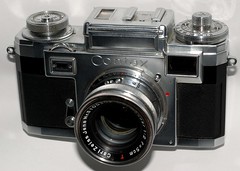Difference between revisions of "Contax rangefinder"
Rebollo fr (talk | contribs) m (fixed the picture) |
(→Links) |
||
| Line 34: | Line 34: | ||
In French: | In French: | ||
* Lionel's [http://35mm-compact.com/anciens/zeissikoncontax2.htm Zeiss Ikon Contax II overview] at 35mm-compact.com | * Lionel's [http://35mm-compact.com/anciens/zeissikoncontax2.htm Zeiss Ikon Contax II overview] at 35mm-compact.com | ||
| + | * [http://www.collection-appareils.fr/general/html/listeX_imagettes.php#zeiss Zeiss page] at [http://www.collection-appareils.fr/general/html/francais.php www.collection-appareils.com] by Sylvain Halgand | ||
In Japanese: | In Japanese: | ||
* [http://www.eonet.ne.jp/~exakta/index.html Archiv Zeiss / Exakta] by Mori Ryōsuke (with some English) | * [http://www.eonet.ne.jp/~exakta/index.html Archiv Zeiss / Exakta] by Mori Ryōsuke (with some English) | ||
Revision as of 21:41, 17 February 2009
The Contax I was a high end 35mm rangefinder camera made by Zeiss Ikon to compete with Leica models. It was released in 1932. The rangefinder had a very large base to enable precise focusing. The focal plane shutter to 1/1000 had a very special design, with vertical travel and metal slats instead of curtains. The Contax I had many small variations during its production. It had a special lens mount to put interchangeable lenses (see Contax rangefinder lenses). The Super Nettel was based on the Contax I, with the same kind of shutter, but a folding body, a fixed lens and a short based rangefinder. It was intended to be a cheaper alternative.
The Contaflex was a derivative of the Contax I. It was a 35mm twin lens reflex with the same kind of shutter and a built in exposure meter. It was an extremely expensive camera, that tested some of the features that would later appear on the Contax II and III. It had interchangeable lenses with a specific lens mount.
The Contax II was released in 1936 and was the successor of the Contax I. It was the first camera with a rangefinder and viewfinder combined in a single window. Its chief designer was Hubert Nerwin. The Nettax was meant to be a cheaper alternative, it was a derivative of the Super Nettel with a rigid body and interchangeable lenses with a specific bayonet and a very limited range of lenses.

|
| Contax IIIa. Picture by rst90274. (Image rights) |
The Contax III, also released in 1936, was a Contax II with an exposure meter. It was one of the first cameras with a built-in exposure meter.
After the war, the Soviet Union captured the tooling and drawings of the Contax as war booty, and transfered them to the city of Kiev, where they began the production of the Kiev rangefinder camera, as such a continuation of the Contax.
At the same time, the Western part of the Zeiss Ikon company, based in Stuttgart, completely redesigned the Contax and launched the Contax IIa in 1950 and Contax IIIa in 1951.
Bibliography
- Barringer, C. and Small, M. Zeiss Compendium East and West — 1940–1972. Small Dole, UK: Hove Books, 1999 (2nd edition). ISBN 1-874707-24-3.
Links
In English:
- Biography of Heinz Küppenbender, chief developer of the Contax at The Zeiss Historica Society
- Contax I and Contax II/III at Cameraquest
- Repair notes in Rick Oleson's website:
- Contax (II-III) shutter ribbons (also applies to Kiev 35mm rangefinder models)
- Contax IIa shutter CLA
- Make a takeup spool for your Contax or Kiev (by Henry Fisher)
In French:
- Lionel's Zeiss Ikon Contax II overview at 35mm-compact.com
- Zeiss page at www.collection-appareils.com by Sylvain Halgand
In Japanese:
- Archiv Zeiss / Exakta by Mori Ryōsuke (with some English)
| Zeiss Ikon Classic Cameras |
|---|
| Contax | Contaflex (TLR) | Super Nettel | Nettax | Tenax II | Tenax I | Ikoflex | Super Ikonta
Contax S | Contaflex (SLR) | Contarex | Icarex | SL706 |